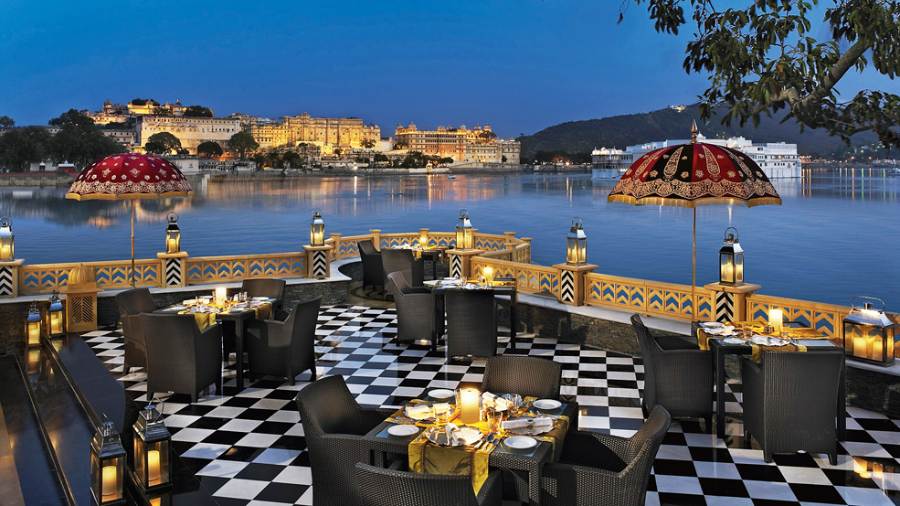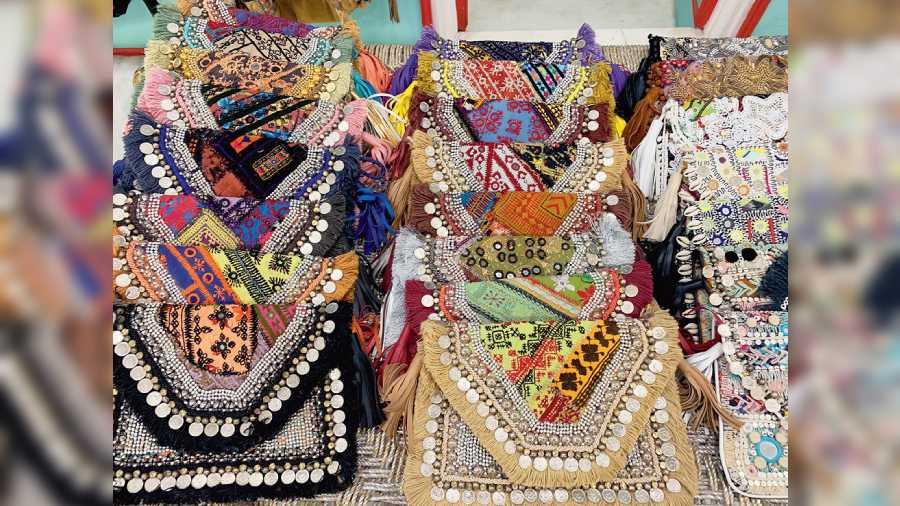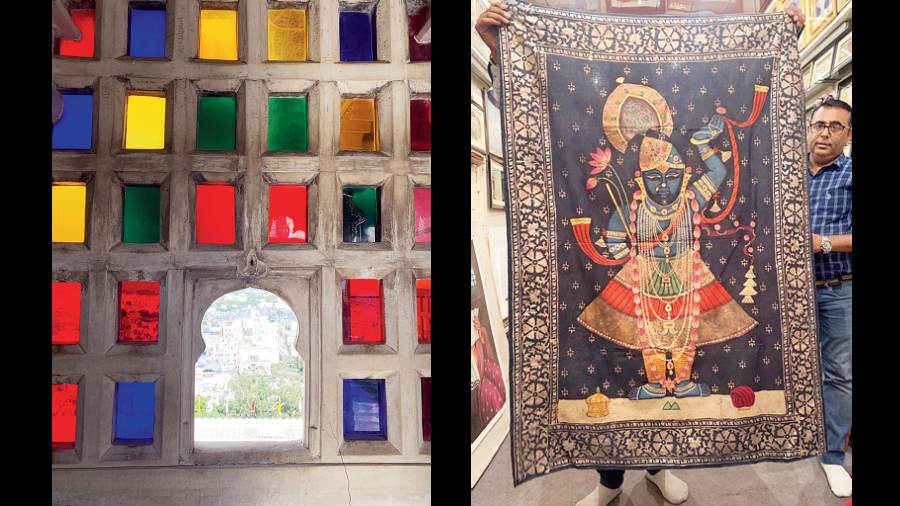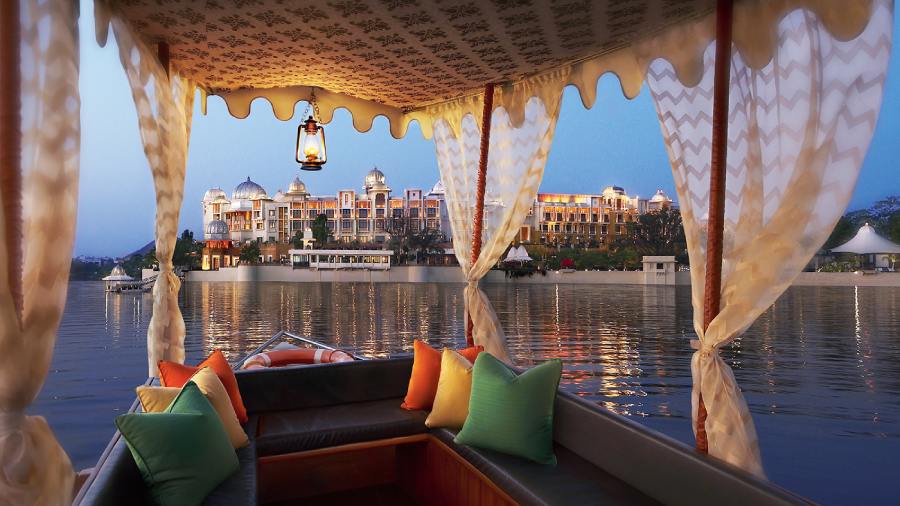Although Udaipur is called the City of Lakes, I somehow imagined it to be dry and dusty desert like much of Rajasthan. I saw no camels, no dirt and grime, clear skies and the weather was breezy like an eternal spring. It is no wonder that so many destination weddings choose this city. Apart from the magic of lakes and water wherever you look, you have marble palaces and jarokhas, an old city which has retained its charm and fabulous shopping if you like textiles and art. Udaipur, the historic capital of Mewar, which is in south central Rajasthan, ticked all my boxes for a short break away.
You would be mad not to stay either on or over the glimmering romantic Lake Pichola. It would be like going to Paris and not visiting the Eiffel Tower. The lake is too beautiful not to be the anchor of your vacation with stunning little islands in the middle.
We stayed at the modern palace hotel, the Leela Palace which isn’t really a palace but like many of the Leela properties, certainly looks like one. It is one of the three luxury hotels on the lake — the other two being the heritage Taj Lake Palace, formerly the Summer Palace of the royal family (actually on an island in the lake… think James Bond Octopussy) and the sprawling Udaivilas.
There are, of course, smaller hotels inside the City Palace and dotted around, all pretenders to the throne as it were. The facades look good but I sensed issues with service and facilities. The Leela has the added advantage of not only being on Lake Pichola but every one of their 70-odd rooms has a lake view.

Lakeside restaurant Sheesh Mahal, which is now in Karen’s top 10 best ‘restaurants in the world with a view’ list è
My room was overlooking their lakeside restaurant Sheesh Mahal, which is now in my top 10 best ‘restaurants in the world with a view’ list. I stay in hotels regularly and it can be quite disheartening to wake up and draw your curtains to a neighbouring wall or even worse, a neighbouring room! The rooms at the Leela are large and tastefully furnished with embroidered silk bed throws. The bathrooms are splendid with large tubs, white marble accessories and you have the chance to try their newly launched signature range of bath and body care, Tishya, which is based on an expression of lotus. It’s the only time (I swear to you) I have ever taken a (complimentary) body lotion from a hotel room, it was that good. Leela has a magnificent Olympic-size pool presided over by two gigantic metal peacocks, a great spa (the hot stone treatment is a must) and an impressive gym for a leisure property.

(Left)Junglee Maas and Laal Maas
Did I mention the food? Chef Simran Singh Thapar is a young man on a mission. Having spent time in France last year, you can expect excellent European dishes including handmade pasta and in Indian, quite frankly the best Laal Maas I have had.
It is a well-documented fact (by chefs not me) that the best mutton (goat) in India comes from Rajasthan — full of flavour and pieces so succulent you can cut them with a spoon. Not surprising then that two of the most flavourful mutton dishes in the country come from this state — Laal Maas and Junglee Maas. The Royal Rajputs from Jaipur and Mewar led an action-packed life; when they were not at war, they spent months pursuing their favourite pastime — shikaar or hunting. Many dishes were invented and perfected on these hunts — Khad Khargosh (hare cooked in a sandpit), Sooar Ki Saanth (curried wild boar), Laal Maas (red meat masala) which was often smoked and Junglee Maas. Junglee Maas contains four basic ingredients — ghee, dried red Mathania chillies, salt and the meat, any meat. The problem is that without those specific chillies and really good quality ghee, the dish just doesn’t taste the same. We exercised our epicurean duty to explore outside the hotel one day and found a pretty good Junglee Maas swimming in a pool of ghee next door at a lakeside restaurant called Ambrai at Amet Haveli. Rough on the edges with none of the sophistication of the Leela but their Junglee Maas, missi roti and velvety palak paneer were spot on.

Sarah Todd of MasterChef Australia fame produced a six-course banquet with some surprising twists and turns on international favourites, all with an Indian edge
Chef Simran’s Laal Maas is cooked till amazingly tender and served in a pool of spicy sauce enriched with a paste of Mathania chillies. I call it a sauce because by the time it is strained and reduced and pampered, it looks more like a French sauce than an Indian gravy. Mathania chillies have a natural smoky flavour and are not as spicy as I expected but Simran’s recipe involves soaking, cooking and grinding them, to reduce the pungency I expect.
Leela is attempting to draw a great focus to their F&B by inviting visiting chefs to do special tasting dinners with their chefs. While I was there, the utterly lovely and very gifted Sarah Todd produced a six-course banquet with some surprising twists and turns on international favourites, all with an Indian edge. It all worked brilliantly. I’ll never criticise vegemite again after her utterly delicious ‘Cheesymite’, a 1,000 layer achaari potato cake with a Parmesan mousse and vegemite beurre blanc!

Fabulously kitsch handbags
Although Udaipur has become a popular wedding destination with cinematic backdrops for everything from a full-blown Mehndi, a Bollywood-level Sangeet and a wedding ceremony by the lake, there’s far more this city has to offer to the ever-exploring traveller. Rich with Rajasthani heritage, the city is vibrant in its own unique way, letting you share as much or as little of that energy as you want.

(left) The City Palace is a must just for the expanse and space and stunning Murano glass windows; For Pichhwai, meet Vinay Gurani at Shreenath Silver & Art who is just outside the City Palace
Take Ganesh Emporium (a definite “must-visit”) in the heart of the city owned and run by the Shah family. Vipul Shah is a name synonymous with fabulously kitsch handbags that are carried by international models and global celebs. His brothers Viral and Vishal run the Aladdin’s cave of a store spread over three floors and many annexes. They spent an unbelievable amount of time with us with no expectation of a sale. We walked away like happy bunnies, excited and enthralled having spent almost two hours looking at textiles, old pichwais and, of course, Vipul’s handbags crafted from antique textiles with the right amount of chamak. We returned the next day to buy, of course, but that’s not because of any pushy salesmanship. Quite the contrary. After checking out many other little stores and emporiums, we realised that they have a truly amazing variety of heritage textiles and art all under one roof with unmatched service and quality.

Juti shops at Hathi Pol Bazaar are worth checking out
The city is chock-full of stunning handicrafts and art but you really need to know where to look. Everyone advised us to go Hathi Pol Bazaar, which quite frankly is a mess and a disappointment except for the juti shops which reminded me of Jaipur 30 years ago (both price and quality). For Pichhwai (the large devotional paintings on cloth), I would strongly recommend you go and meet Vinay Gurani at Shreenath Silver & Art who is just outside the City Palace. He will explain the old and new and distinguish the exquisite from the ordinary. Ganesh Emporium jack up the prices a bit for their art but their superb framing is impressive. Emporiums are aplenty throughout the city but I would opt for a wander around the Old City any day… narrow streets, interesting shops, tailors and cobblers and temples, knock-off Vipul Shah handbags (look at them carefully if you are tempted)… it’s a wondrous paradise for the shopaholic.
Let’s go sightseeing
The City Palace is a must just for the expanse and space and stunning Murano glass windows. The Monsoon Palace, which is a fair drive away up a hill, looks dreamy from Lake Pichola, but it isn’t so once you get there. Unkempt and disappointing except for the view. If you have time, then, of course, a walk along the Fateh Sagar Lake overlooking Nehru Park and surrounded by Swiss-like water jet fountains (all the lakes in Udaipur are manmade and created by the ruling Maharaja in the 14th century as part of a grand water management scheme to meet the drinking water and irrigation needs of the city) is a morning well spent.
A visit to the Saheliyo ki Bari gardens and the surrounding neighbourhood was last on my bucket list only because of the constraints of time. A city like Udaipur needs at least three to four days to truly get a feel, which is exactly what I did. A long weekend works but I, for one, am now curious and longing to return to explore more.
Karen Anand is a culinary consultant, food writer and entrepreneur. In recent times her name has been synonymous with farmers’ markets. Follow her on www.facebook. com/karenanand and on Instagram @karen_anand
